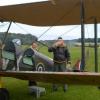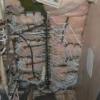

Chris B
Gold Member-
Posts
162 -
Joined
-
Last visited
About Chris B

- Birthday 26/12/1947
Contact Methods
- MSN
-
Website URL
http://
-
ICQ
0
Profile Information
-
Gender
Male
-
Location
North Devon
Recent Profile Visitors
2,894 profile views
Chris B's Achievements

New Member (2/9)
105
Reputation
-
mylo66 "Dont forget the Meng MK iv" That Meng is indeed a nice kit. I've made 3 - Male, Female and Hermaphrodite. I think however that you'll find it's a Mark V not a Mark IV 🙂.
-
I've cut and trimmed vacuform canopies but never tried cutting unmarked gun slits. Thinking about how I'd do it - 1. fill the inside of the transparency with something like Blu-tack or stuff hard with damp tissue, the aim being to keep it from deforming under pressure 2. use something like Tamiya masking tape to outline the slit 3. use a drill as near as possible to the width of the slit to drill 3 or 4 holes down the slit. 4. trim up to the tape up with a new sharp modelling knife blade or small sharp scissors
-
In 1/35th I've built 2 Takom Mk1s, - male and female, 3 Takom Mk IVs - male, female and tadpole and 3 Meng Mk V - male, female and hermaphrodite. All the kits except the first (probably a Mk IV male) have included the single link track pads as opposed to the original Takom over fiddly multi part track pads. Are they simple and easy 'shake the box' buildable? In my opinion no. They all have a few potential problem areas and having at least partial use of 2 hands is useful (I have limited use with the left hand). They do however get easier to build the more you make and as you learn ways to deviate from the instructions or simplify the build. For example, don't try to install the insane no. of wheels into the side frames without gluing them into one frame side as near as possible at 90%; then allow to partly dry before attempting to place the second frame over them, working along the length pushing them with a suitable prod (I used a small file) into the location hole . Alternatively given that the wheels are hidden once the track is on, the no. of wheels can be reduced to say half a dozen each side. When building the sponsons I found it advisable to keep trying them for fit against the hole in the frame as they're built before the glue sets. As regards the 1/35th Emhar kits, I built a couple probably about 30 or so years ago. I remember them as rathe crude and basic compared to both the Takom and Meng kits. I afraid I can't remember how easy or difficult the builds were. My opinion is that probably their only advantage is that they're cheaper than Takom or Meng. If you do think about trying a Takom or Meng, as well as looking at the 'work in progress ' build on this site I'd strongly recommend looking at the build reviews on the PMMS site e.g. https://www.perthmilitarymodelling.com/reviews/vehicles/takom/takom2008-9.html where you you will find many useful suggestions to help the build. (N.B. the above link mentions the ridiculously complex tracks in the first kits, not those now included in the Takom kits). Regards Chris
-
Chris B started following AFV Club Valentine Mk I , Building Vacformed Models and Help Request - HMS Barham or Malaya - 1916 Jutland
-
Ah this brings back happy memories. I printed off this this excellent tutorial many years ago when I ventured into vacforms. I also remember my son and I standing watching John demonstrating how to deal with vacforms at Donnington IPMS Nats, can it be 25+ years ago? I've still got a couple of lengths of T Al, sticky pads, a Sandvic and a very old packet of bicarb in my modelling drawer but advancing age and declining dexterity means that I usually stick to 1/35th AFVs these days. Mud and tarps can hide a multitude of errors 😉
-
Dick Taylor's 'Warpaint' vol. 1 says that there is no definitive record of paint spec. or names during WW1. His view is that in 1915 - 1916 the standard colour used was what was called 'Service Grey'. This seems to have been a Blue/Grey shade. Later in WW1 he says that the colour changed from Service Grey to 'Service Brown' although "some records point to Khaki and Greens also being used". He mentions that there seem to have been at least 3 brown shades. In a nutshell, some shade of darkish Grey or brown would probably be appropriate. I'll use a roughly similar mix I've used on my Mark IVs - 50% XF55, 50% XF52
-
I like the weathering and exhaust staining and I'm envious that you managed to get the cable lines through the etch over the side lights and horn (assuming that's what they are 🤔). Something I singularly failed to manage. I started mine about a year ago and it stalled when it came to the etch bits on the bodywork. I've recently picked it up again and the etch bits are now, more or less, where they're supposed to be. Having recently finished a Tamiya Archer which was a breeze to build I've found the AFV Valentine 1 to be somewhat of a challenge.
-
I've bought some Penguin decals from Jadar with no problems.
-
Andy I always leave paint at least 24 hours before either glossing for decals or more usually applying a coat of my old bottle of 'future' (a type of acrylic floor polish that alas is no longer available under that name) to the decal area. As regards applying superglue I've a large (cheap) pack of 1.5 inch long pins that have a small plastic ball on the blunt end that I use instead of wire.
-
Andy Having a slightly longer track made using single links happens to me quite a lot. It's just now happened on the Tamiya Archer I'm making.when I've had to shorten a link and try and find somewhere where it will not be obvious. If you'e lucky with the type of AFV it can be hidden behind a track guard or skirt. It the gap is say half a link I might very slightly shorten up to half a dozen individual links. Another possibility if the gap is small is to remove a section of the top or bottom run, brush on some mek, leave for 10 or so minutes and it's sometimes possible to very slightly stretch the spacing between the links.
-
Afraid I've never tried the Tamiya extra thin so can't say how that would work in the way I assemble individual track links. Being very much a creature of habit, mek has always worked for me so better the devil you know
-
Yes that's the sort of tool that makes folding etch MUCH easier and more precise. Mine's an early version of the 4 inch 'Hold and Fold' (strictly speaking a 'H and F' is made by 'The Small Shop' https://thesmallshop.com but has become a generic description of the type of tool). I see that the current 4 inch H and F costs around £50 in the UK. H and F are made in the USA and the pound/dollar exchange rate was a great deal better when I bought it. Mek is short for Slater's Mek-Pak . https://slatersplastikard.com/plastikard/mekpak.php. I've used it instead of something like Plastic Weld for the last 20 years or so (I'm a creature of habit), although I also use Revell Contacta for some things. I buy a couple of the 50 ml bottles direct from Slaters every year or so when supply is getting low. So far I've had no problem with postage..
-
That looks to be coming along nicely. I made both a Mk1 and mk2 a couple of years ago when they first came out. I remember finding a few things a it fiddly including working out the exact angle on the etch bits that fit over the top run of the tracks at the front . Looking at Google pics helped. I thought the tracks looked a pain and left them until late in the build. When it came to it they were not too bad using my usual method of using mek to join several pairs of links against a straight edge, leaving them for 5 minutes, join the pairs into 4s, leaving for 5 minutes, 4s into 8s and so on until I had the required length. Then a light brush of mek along the length, leave for 10 - 15 minutes and then whilst together but still bendable, onto the model. I painted the tracks when on using a fine brush having airbrushed the rest of the model If you're going to use etch again I'd strongly recommend a tool such as 'hold and fold' (other makes are available). Not cheap but it'll probably last forever and has made working with etch much easier.
-
An interesting question. Having just looked for an answer in the book " Into the Vally" I'm not entirely clear what the answer is. There's a small pic of "fuel being pumped in by hand" which shows a line going into an area at the edge of the transverse inlet covers/louvres on the left side (looking forward). The accompanying caption says "Early Valentines had hinged side plates, allowing the fuel tank to be filled without lifting the whole top louvre." A schematic diagram of the engine bay (that unfortunately does not show the louvres) shows the "fuel filler cap" as as possibly being under where the second or third louvre counting from the rear would be. I think it's a reasonable assumption that the fuel filler cap is hidden under one of the inlet louvres.
-
Scale is 1/35.
-
A very nice build and paint job of what I'm finding to be rather a 'fiddly' kit. I've just about finished the hull on my attempt but the build is stalled as I'm now painting and papering a 1:1 front room. One small point that caught my eye where your build differs from mine concerns the 2 handles on the engine cover louvres. Your's are angled inwards from the attachment points, towards the cover without handles, whereas I've angled mine outwards from the attachment points. Looking at the book "Into the Valley" photos of the Mark 1 with the 2 handles and the later Marks with 4 handles, all seem to show the handles to be angled outwards.






